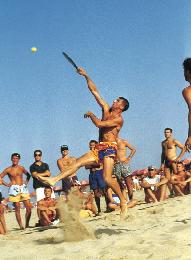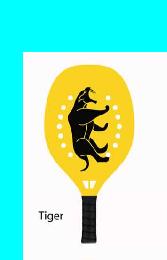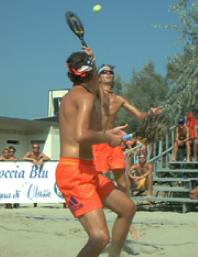| ||||||||||||||||||||
| ||||||||||||||||||||
 |  | |||||
 | ||||||
The present general regulation is made by IFBT to provide the rules for the competitions. | ||
BEACH TENNIS, GYM RACKET & RACKET VOLLEY RULES GENERAL REGULATION The present general regulations are established by I.F.B.T. to provide the rules for the competitions. FOREWORD The International Federation Beach Tennis is divided into three fields: • Beach Tennis: played on the sand • Gym Racket: played indoor on hard or grass surface • Racket Volley: played with string racket on the sand RULE N. 1 - PLAYING AREA For Doubles Matches, the playing area must be 52.50 feet (16 m.) of lengths and 26.24 feet (8 m.) of width. It must be divided into two equal parts by a net, with small meshes so that the ball cannot pass through. For Singles Matches, the width is 16.40 feet (5 m.) and keeping the same lengths as in doubles. RULE N.2 - PERMANENT FURNISHING Permanent systems consist of: Net, stakes, lines or rope Net height: • Beach Tennis and Racket Volley: 67 inches (1.70 m.) • Gym Racket: 70.8 inches (1.80 m.) Perimeter lines: • Maximum width of 2 inches (5 cm.) • Contrasting color with the sand or surface of play RULE N.3 - THE BALL Official I.F.B.T. approved balls are depressurized: • Beach Tennis & Gym Racket: size 2.5 inches (6.4 cm.) and mass 38 – 40 grams (ex. Artengo 710). • Racket Volley size 3.0 inches (7.6 cm) and mass 44 grams (ex. Artengo 700). RULE N.4 - THE RACKETS Beach Tennis and Gym Racket: • Maximum length: 21.65 inches (55 cm) • Maximum width: 11.81 inches (30 cm). • No string • Flat surface, with an indefinite number of holes Racket Volley: • Maximum length: 30 inches (73.7 cm) • Maximum width: 12.5 inches (31.7 cm) • Strings as tennis rackets.
RULE N.5 - SERVER AND RETURNEE • Players must be opposite each other • Server: the player who throws the ball first • Receiver: the player who receives the serve
RULE N.6 - SIDE AND SERVICE DRAW The right to serve first or be the receiver, at the start of a match is decided by a draw.
The player who wins the draw may choose one of the following options: 1. Service Option: Serve first or receive first 2. Side of the Court Option: which side the players will start play
The draw winner may also elect that the opponent chooses first one of the above options. The loser of the draw may select their preference in the remaining option, such as which side they want to start to play if
RULE N.7 - THE SERVICE • The Server must always serve outside the bounding line. Should the server infringe this rule, he loses the point. • The Server has 1 opportunity to serve per point. | ||
RULE N. 8 - SERVICE FAULT
Service fault occurs when: the player misses the ball while trying to hit it; the serviced ball hits a permanent furnishing, the area bounding net, the walls or the ceiling of a possible gym before touching the ground; the server invades his side before hitting the ball.
Service fault occurs when the server touches or treads on the bottom line. (Foot fault)
RULE N. 9 - SERVICE ORDER
Under penalty of loosing the point, each player must alternate at the service, following a pre-established order previously reported to the judges.
RULE N. 10 - WHEN PLAYERS CHANGE THE COURT SIDE
During matches, players must change sides at the end of each odd game.
RULE N. 11 - SCORE
Game score:
• 0 (love), 15, 30, 40 and “game”.
• If both players have scored three points each (deuce), it is required that one player (team) must win one point to win the game.
Set score: The winner is determined by the team who scores 7 (or 9) games with a margin of at least 2 games. A tie-break is played at 6 (or 8) games all.
RULE N.12 - TIE BREAK
Only one more game is played to determine the winner of the set; the score of the set is always 7–6 (or 6–7). Points are counted consecutively using ordinary numbering. The set is decided by the player who wins at least seven points in the tiebreak but also has two points more than his opponent.
The player who would normally be serving after 6–6 or 8-8 is the one to serve first in the tiebreak, and the tiebreak is considered a service game for this player. The server begins his service. After the first point, the serve changes to the first server's opponent. Each player then serves two consecutive points for the remainder of the tiebreak. After every four points, the players switch sides of the court.
RULE N. 13 - HOW TO DETERMINE POINTS
• Each time the ball touches the own bounding playing field, the point is given to the opposite team.
• If a player sends the ball out of the bounding playing field he loses the point.
• A ball that touches the bounding lines is considered “in”.
• If a player intentionally disturbs the opponent while hitting the ball, he loses the point; if not intentional then the point is replayed.
• The receiver’s return of serve is considered “good” and is effective should the ball hit the net, as long as it passes over it and touches ground within court.
• It is not legal to return while invading the opponent court.
RULE N. 14 - OFFICIALS DECISIONS
In a match where a referee is named, his decisions are definitive.
RULE N. 15 - COMPETITION MANAGER OFFICIALS & REFEREE
All the official competitions must be controlled by an I.F.B.T. Manager; all participating Officials and Referees must have the specific license and will be organized in an official Registration. The Federation will organize stages and courses.
RULE N. 16 - COMPETITIONS
Contests are divided as follows:
• Regional Championship
• National Championship
• Continental Championship
• International Championship
All Tournaments and competitions must be authorized by the Federation. A calendar of the events for each season will be made with respective charts. In order to organize a tournament, each nation must ask the Board of Directors at least 30 days in advance.
Competitions are divided according to player’s age:
• Under 14
• Juniors under 18
• Senior 19-39
• over 40
• Open
Competitions are also divided into two categories: Professional & Advanced.
International Federation Beach Tennis
Competitions & Ranking Committee
